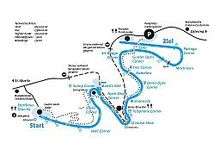St. Moritz-Celerina Olympic Bobrun

The St. Moritz-Celerina Olympic Bobrun (known officially as the Olympia Bobrun St. Moritz-Celerina) is a bobsleigh track located in St. Moritz, Switzerland. Constructed in 1903, it officially opened on New Year's Day 1904 and is the oldest bobsleigh track in the world and the only one that is naturally refrigerated. It is also used for other sliding sports, including skeleton and luge.
History
The track was initially created for winter guests from Great Britain who created bobsleigh. In 1897, the St. Moritz Bobsleigh Club was created.[1][2] Because of popularity of the sport, fund raising for a track begin which was completed in 1903 with CHF 11,000 raised. The track served as host to the bobsleigh events for both the 1928 and the 1948 Winter Olympics.[3][4] Track modifications have been made several times since the 1948 games, especially on the lower part of the track to meet the demands for higher speeds of the sleds and the increased braking issues after the end of the run. The Horse shoe curve, constructed of natural stones, was strengthened and its height and radius increased during the winter of 1995 and 1996 with a second and final modification taking place in 1995. This was also important with the addition of tour guides to the track that began in 1973 in terms of the wear and tear on the ice. In 1972, the Dracula Start House (Starthaus Dracula in (German)) was demolished and a new structure was created to meet the needs of the bobsleigh organizers with further renovations done in 1992, 1993, and 2002. The last additional modification took place in 2002 with the addition of a runoff after the Portago curve that lead to the Frizzoni's Finish lodge.[1]
Current track turns and length

The track, with 14 named curves, is 1,722 meters long with an elevation difference of 130 meters and an average grade of 8.14%.[5] The curves were given most of their names by the British, which remain to this day.[2]
| Turn Number | Name | Reason named |
|---|---|---|
| 1. | (Start) | Start at the start house "Dracula", after founder of the Dracula Club created by current St. Moritz Bobsleigh Club president Gunter Sachs. |
| 2. | Wall Corner | After a wall used to support the bobsleigh and skeleton turn. |
| 3. | Snake Corner | Curvy like a snake. |
| 4. | Sunny Corner | Sunniest part of the track. |
| 4a. | Monti's Bolt | Named for Italian bobsledder Eugenio Monti who, during the two-man event at the 1964 Winter Olympics in Innsbruck, gave a bolt from his sled to British bobsledders Anthony Nash and Robin Dixon to repair their sled. Nash and Dixon would win gold in the event at those games. This turn serves as the start point to luge for the women's singles and men's doubles event. |
| 5. | Nash-Dixon Corner | Named for British bobsledders Nash and Dixon, gold medalists in the two-man event at the 1964 Winter Olympics in Innsbruck, the only members of the St. Moritz Bobsleigh Club to ever do so. |
| 6. | Horse-Shoe Corner | Omega curve shaped like a horse shoe. |
| 7. | Telephone Corner | Where the first track telephone was installed. |
| 8. | Shamrock | |
| 9. | Devils Dyke Corner | |
| 10. | Tree Corner | There is a tree in the short wall of this corner |
| 11. | Bridge Corner | As you exit this corner you can see the train bridge over the upcoming track |
| 12. | Leap | |
| 13. | Gunter Sachs Corner | After the president of the St. Moritz Bobsleigh Club from 1969 to 2011. |
| 14. | Martineau | After Hubert de Martineau, a Major in the Swiss Army, who was president of the St. Moritz Bobsleigh Club from 1922 to 1969. |
| 15. | Portago Corner | After Alfonso de Portago (1929–57), who won the bronze medal for Spain in the two-man event at the 1957 FIBT World Championships held in St. Moritz only to die later that year during the Mille Miglia race in Italy. A foundation in his name was important in the renovation of the lower part of the track. |
| 16. | (run-out) |
Track construction
The track construction begins around the middle of November and takes a crew of fifteen ice workers from the Tyrol region of Austria and Italy a total of three weeks to construct the track using 5000 m3 of snow and 4000 m3 of water. Construction follows the entire length of the track from start to finish. Because it is a natural track, length and elevation changes occur annually during construction. Once construction is complete, the fifteen workers split up into respective sections to maintain their area during the season which is done every afternoon and can take up to four hours. Once the bobsleigh and skeleton season concludes in late February or early March, track dismantling begins and continues until the middle of June.[6]
Track records
Because this is a natural track that is constructed and changed on an annual basis, there are no start records and track records.[6]
Championships hosted
The track has hosted FIBT World Championships a record 22 times:
- Bobsleigh (four-man) 1931, 1935, 1937
- Bobsleigh (two-man) 1938, 1939
- Bobsleigh (two & four-man) 1947, 1955, 1957, 1959, 1965, 1970, 1974, 1977, 1982, 1987, 1990, 1997.
- (men's skeleton)1989, 1998
- (men's Bobsleigh) 2001
- (men's, women's Bobsleigh) (men's, women's Skeleton) 2007
- (men's, women's Bobsleigh) (men's, women's Skeleton) (Mixed Team) 2013.
- FIL World Luge Championships: 2000
References
- 1 2 History of the track (English)
- 1 2 St. Moritz Bobsleigh Club official website (German)
- ↑ 1928 Winter Olympics official report. Part 2. pp. 12-13. (French)
- ↑ 1948 Winter Olympics official report. pp. 6, 23. (French) & (German)
- ↑ FIBT track profile
- 1 2 Track construction details (English)
External links
- FIBT track profile - Number of championships listed is incorrect on the webpage (Shows 17 when it is 21).
- Olympia Bobrun (Official website) (English), (German), & (Italian)
- St. Moritz Bob Club History (German)
- St. Moritz Celerina Olympic Bobrun (English), (German)
- St. Moritz-Celerina Olympic Bobrun on Google Maps
Coordinates: 46°30′05″N 9°50′51″E / 46.501516°N 9.847418°E
